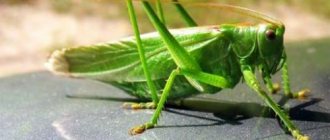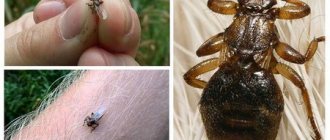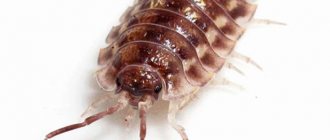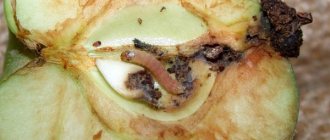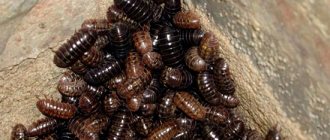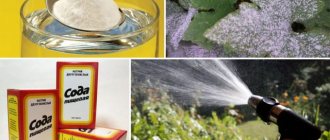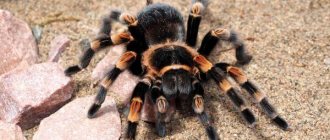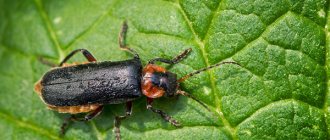Those caterpillars that eat apples are moths . And these are the most common and dangerous pests (since there are several types of them).
The most common are apple and oriental. These are butterflies whose larval stage feeds on both the pulp and seeds of the growing apple tree fruit. What causes its early fall and rapid decay. During a pest outbreak, up to ¾ of the entire apple harvest may be lost. In this article we will tell you how to save an apple tree from the codling moth .
Symptoms and characteristics of the insect
Symptoms of damage are increased flight of butterflies 12-17 days after flowering, as well as the presence of 1 to 5 or more microscopic holes on apple ovaries. Also, the appearance of carrion in the form of apples that look full-sized, but when cut open there are gnaws inside them and the seed chamber has been eaten away.
Eastern codling moth on an apple tree
The oriental codling moth is a dangerous quarantine pest of apple trees. Because in the South it develops in five generations and one apple can sometimes be inhabited by 5-7 larvae “worms”. Because of this, it can completely deprive a summer resident of his apple harvest .
Spreading
This butterfly is distributed throughout the European part of the Russian Federation (with the exception of the tundra zone), as well as the Caucasus and Transcaucasia, the Far East and the Baikal steppes, Central Asia, Siberia, Altai, Southern Belarus and Ukraine . It is most harmful in the steppe zone of Ukraine, the Russian Federation and the mountainous Crimea.
The effect of humidity on the pest
The number of this butterfly is most strongly influenced by atmospheric phenomena.
And in particular, the massive death of its caterpillars is observed during long periods of drought and heat (almost 100%), when the moisture in the atmosphere decreases to 30%.
Note! The general death of caterpillars before they penetrate into ripening apples in the northern zone and in the Non-Black Earth Region during dry and hot July is observed much more often than usual.
Caterpillar - what is it?
A caterpillar is a small plump worm . The body is pink or pinkish-reddish in color with grayish dots and has no hairs or pubescence.
The head and cephalothorax are chitinous, reddish-brownish in color, dark and stand out brightly against the apple background. True legs with walking claws are observed.
The hind legs, which are not real, also have claws. The body length of the caterpillars sometimes reaches two centimeters. Below you can see what a codling moth looks like on an apple tree - photos in different life cycles:
Apple codling moth caterpillar.
Codling moth butterfly.
Life cycle of a pest
The cycle with complete transformation, characteristic of the genus of butterflies, consists of the flight of adult butterflies, their mating, the butterfly laying eggs in secluded places, the birth of first instar caterpillars, searching, penetration into an apple and the caterpillar feeding on the fruit, leaving the fruit for pupation.
Important! Due to the dynamism and presence of diapauses, the duration of each of the listed stages is variable and varies greatly among gardening zones.
Number of generations
In the north, in apple orchards, there are two generations of the common codling moth, in the south there are three generations, and for the eastern species and in the southern regions of the Russian Federation the number of generations can reach up to five.
First generation
In the northern regions of apple orchards, the first generation appears from the moment small apples grow, that is, from the end of May to the end of June . In the south it can be noted as early as the beginning of May.
Overwintering stage
In the winter period, as a rule, caterpillars of 4-5 instars enter, in impenetrable silky white cocoons. Most often this is the second or third generation of the moth in a given year.
Apple tree varieties not affected by the codling moth
At the moment, there are no varieties of apple trees that are absolutely resistant to codling moths .
The only thing that gardeners have accurately noticed is that apples with tasty and very tasty pulp are more often and more intensively damaged by codling moths, but varieties of the “juice” direction are less “favorite” by caterpillars.
Types of codling moth:
Apple moth
This is the most common and well-known type of this pest. The larvae infect not only apple trees, but also pears and peaches, apricots and plums. Special forms of this species can successfully survive even in walnut fruits. Caterpillars overwinter in a dense cocoon. The number of generations per year depends on the climate.
Eastern codling moth
This is a dangerous pest that eats the fruits and shoots of many fruit crops. Peaches, pears and quince are especially at risk. In areas of distribution, the eastern species of the pest destroys up to 100% of the crop. In southern countries, up to 6 generations of this moth can develop in one season.
Pear moth
Most often, this monophage devours pear fruits. This type of pest is especially dangerous for early varieties of pears. Caterpillars overwinter in cocoons in the soil; the generation is one-year, although sometimes a second generation can develop in one season.
Please vote for this article:
Codling moth on an apple tree: methods of control
Methods of struggle are:
- Agrotechnical;
- Chemical;
- Mechanical;
- Biological.
Attention! Only their simultaneous use will help defeat the codling moth.
Apple trees that are pruned correctly and on time, fed, watered and with properly maintained soil can resist the invasion of these pests. Trees weakened by frost, hail, or overfed with “organic nitrogen” are much easier and more susceptible to pest damage.
In addition, it is necessary to maintain bio-balance in the garden and expand the bio-diversity of species, then natural predators and enemies of codling moths will be able to destroy up to half of the pest, thereby protecting the garden from insect invasion and the use of synthetic poisons on apple trees.
Trichogramma is a natural enemy of the codling moth.
How to fight the codling moth on apple trees? Create conditions under which the development cycle itself will be either impossible or severely disrupted. And the tree and its fruits will become the least suitable for the moth caterpillars to spread and eat.
Watch the video of Oktyabrina Ganichkina’s advice on how to save the apple tree harvest from the codling moth butterfly:
Area
In the 20th century, the species spread widely across the globe from its original small East Asian range. Introduced to Australia, to the USA (District of Columbia), from where it populated North America from Canada to Mexico. Introduced to Italy, from where the species spread throughout Southern and then Central Europe, including France, southern Germany and Romania. Found in Spain. Its current range also includes the Middle East, South America, Australia, New Zealand, North and South Africa.
What helps a butterfly survive?
Its abundance, reproduction by several generations per year and secluded wintering places contribute to this.
Wintering places can be like this:
- In “old” apple orchards, most of the wintering cocoons are located in cracks in the bark, at a distance of up to 60 cm from the ground plane, and others are in the soil near the apple trees themselves, as well as in humus storage areas, supports, chatals, stakes, all kinds of buildings and others shelters located directly in the garden;
- In young gardens, caterpillars overwinter mainly in the ground at the “root collar” at a depth of up to 8 cm, not counting the fact that codling moth caterpillars overwinter in packaging substrates, in box containers, in places for storing apples and they end up there spoiled by them or apples.
Treatment Chemicals
Spraying of apple trees against harmful insects is carried out with synthetic chemicals based on organophosphorus compounds . But both neonicotinoids and pyrethroids can be used. Below we will look at how to treat an apple tree against codling moths and when, so as not to damage the crop.
Fitoverm
The effect of aversectin (Fitoverm) is complex : penetrating into the caterpillar by absorption into the outer shells during spraying, or after eating apples treated with poison, the poison affects the nervous system of the caterpillar, causing its death.
Attention! The effect of a substance based on “aversectin-S” lasts up to 20 days and cannot be used when pouring apples!
Can we use herbicide?
This is a typical “scam” of modern traders. This substance has nothing to do with HZR, but it can ruin the life of apple trees, because the herbicide is a poison for plants and certainly does not harm the caterpillars.
Advice! Carry out chemical protection of apple trees only with proven preparations from special stores!
Pesticides
Here are the most effective pesticides available on the market that will be effective against worms in apples:
- Pyrethroids: Kinmiks, Karate-Zeon, Lambda-cypermethrin, Sumi-alpha;
- Organophosphorus: Pirimiphos-methyl, Actellik;
- Neonicotinoids (acting systemically): “Tanrek”;
- "Confidor";
- "Talstar";
- "Ram";
- "Fastak".
All of the drugs listed above are from the neonicotinoid family. And all artificial pyrethroids are lipophilic substances that are excellently retained by the cells of apple leaves and fruits and partially penetrate them, guaranteeing an absolute insecticidal effect on caterpillars. But they are applicable only a month before ripening.
Mixed insecticides
How to spray apple trees against codling moths if the garden was previously treated haphazardly and the emphasis was on one particular poison for a number of years? In this case, it is necessary to spray the apple trees with mixtures of poisons. The following tank mixtures are most suitable for this:
- Imidacloprid + Lambda-cyhalothrin;
- Thiamethoxam + Chlorantraniliprole.
Organophosphate insecticides
These compounds (the most famous Dichlorvos, Fozalon, Karbofos, Fufanon ) turned out to be persistent and toxic to nature organochlorine compounds.
These compounds have a low consumption of substance per unit area and a high speed of action on the codling moth, which has made these substances leaders in the fight against caterpillars.
Features of reproduction
The caterpillars survive the winter in cocoons, from which they emerge early in the spring. When stone fruit trees bloom, butterflies begin to fly. A little later, when the fruits begin to ripen, the butterflies will lay eggs. For this they choose leaves, shoots and, of course, fruits. Each individual can lay from one hundred to two hundred eggs. After 5-10 days, the larvae will hatch.
Having hatched, the caterpillars penetrate into the young shoots through the upper buds. They then chew out an exit hole, which they use to move on to the next shoot. The ability to feed inside a shoot is inherent only in the eastern codling moth - this distinguishes it from other similar pests.
Damaged branches begin to wither and subsequently dry out. Those larvae of the eastern codling moth that fall on the fruits bite into the pulp, unhardened seeds and seeds. Moreover, on one, for example, peach there can be up to 10 pieces.
After the caterpillars have finished feeding, they begin to pupate, choosing for this purpose damaged shoots, fruits or any other shelters in the crown of trees. After a short period of time, butterflies emerge from the pupae. In just one season, an adult butterfly can give 4-6 generations. Moreover, by the middle of the season, the first generation has already laid eggs, so you can encounter all stages of the harmful insect at the same time.
At a time when the codling moth begins to multiply en masse, it can completely destroy the entire crop of peaches, and 70-75% of quinces and pears.
Spraying timing
The timing of when to spray apple trees against codling moths varies greatly for each region of the Russian Federation and for each spring. Therefore, it makes no sense to indicate them, since they are determined locally by the time the flight of adult butterflies begins in the spring and its intensity.
in spring
Organophosphorus preparations showed the greatest effectiveness during spring treatment . They destroy the caterpillars during their birth and the pest does not have time to “reach” the small apples. The most effective ones will be:
- "Calypso";
- "Admiral";
- "Sirocco";
- "Zolon";
- "Lannat-20L";
- "Pirinex";
- "Chlorpyrifos".
After flowering
During the mass flight of butterflies, the poisons “Insegar”, “Dimilin”, “Herold” . These drugs belong to the group of insect growth and development regulators. Females lay eggs on a poisoned surface, so the caterpillars will inevitably die.
Combinations of synthetic poisons are also suitable, for example, Thiamethoxam + Chlorantraniliprole .
During the period of fruit ripening
The use of belts, pheromone traps, biological products and decoctions of herbs poisonous to caterpillars is permitted at the time of ripening of summer and autumn apples.
Carefully! The use of synthetic poisons during this period is prohibited!
Dates in autumn
As soon as the leaves have fallen, you can spray and clean the apple orchard in the fall. They spray the crowns with poison, and scrape the trunks and branches of old bark. You should not do this before these deadlines.
Spraying the garden after the leaves fall.
The first period when to treat apple trees against codling moths is early spring. Before the apple trees themselves begin to bloom.
The treatment period consists of two parts - before flowering and after. It ends when the apples begin to “gain color.”
How often should I spray?
In places where the codling moth forms 2 “waves,” winter apples need 4 sprays, and summer apples two.
In conditions where three generations of codling moth develop, 5 sprayings are recommended for summer and autumn varieties and 7 for winter ones.
Time of processing:
- Quiet cloudy day and complete calm;
- Pre-dawn or sunset hours.
Because in the heat, the preparations reduce their “toxicity” , and the wind will reduce the quality of processing.
Spraying times in regions
In the south of Ukraine, in the Lower Volga region, Rostov region, Stavropol Territory, spraying should begin 12-15 days after the end of flowering. Repeat spraying approximately 11-18 days after the appearance of the first caterpillars in the first carrion.
In the zone of the North Caucasus, the south of the Lower Volga region, in the Krasnodar Territory, the first spraying is carried out 9-11 days after the end of flowering of apple trees; the second - usually 21 days after the first, and the third - when live caterpillars are found in the carrion; the fourth - 14-19 days after the third.
Additional treatments are possible only in the event of a pest outbreak and only for “winter apples.”
Cabbage pests: leaf beetle, cabbage fly
The cabbage fly is a flying insect that in appearance resembles an ordinary fly, but its body size is more compact and is about 5 mm. The fly begins its destructive activities in May, when it begins laying eggs. The laying is carried out directly into the ground, in close proximity to the cabbage seedlings. After about 10 days, the eggs hatch into voracious larvae that feed on tender roots.
It is not difficult to determine whether a plant is affected by cabbage fly. The plant begins to lag in growth and looks lethargic. As the root system deteriorates, symptoms become more obvious. Initially, the lower leaves acquire a lead color, and after a few days the plant dies completely.
The photo shows the cabbage leaf beetle and its larva
If you notice something is wrong, you need to water the beds with Thiophos solution or spray the cabbage with dust. Traditional methods help by watering the soil next to the bushes with vinegar essence at the rate of 1 tablespoon per 10 liters of water. It is quite effective to sprinkle the rows with tobacco dust, mothballs, mustard, and hot pepper.
Cabbage leaf d is a small green bug that itself is not dangerous to the plant. However, it lays eggs, from which larvae hatch and readily eat cabbage. As a result, the farmer notices the appearance of characteristic damage on the leaves, as shown in the photo.
Tobacco dust, ash, slaked lime - these are time-tested substances that can be sprayed on cabbage. It is possible to catch insects using glue traps placed on the garden bed. Using poisons is guaranteed to help get rid of the leaf beetle. The preparations “Karate” and “Aktara” will quickly destroy beetles and their larvae.
Cabbage pests: bugs and cutworms
Cabbage bugs are very prolific pests that feed on plant sap. A characteristic light spot forms at the site of the bite, as can be seen in the photo. Bacteria, viruses and fungi can penetrate through the wound, causing various cabbage diseases.
The photo shows a cabbage bug and a lightened area of the affected leaf.
Cabbage bugs are repelled by naphthalene, which is pre-mixed with sand and scattered between the beds. Spraying the leaves with tobacco, a decoction of potato tops with onion peels are safe but effective methods of control. Chemical preparations “Phosbecid” or “Belofos” will help get rid of insects even during massive attacks.
The moth moth is an insect that reproduces quickly, especially in the southern regions of Russia. The butterfly lays eggs, which it attaches to the bottom of the leaf. Soon voracious larvae emerge, actively feeding on cabbage leaves and gnawing holes in them. The pest is predominantly nocturnal, hiding during the day at the base of the cabbage stem. The use of traditional repellents and poisons allows you to get rid of cutworms on cabbage.
Pictured is a cabbage cutworm and its caterpillar
Caterpillars are a fairly common problem. Among various insects, the ones that most often cause damage to crops are:
- Cabbage white caterpillar. It has a yellow-green color, a body length of up to 6 cm. The caterpillar is generously covered with long hairs and has a good appetite.
- Turnip white. The caterpillar is green in color and eats only the tender flesh, but ignores the veins, leaving the leaf skeleton intact.
- Rapeseed sawfly larvae. They eat leaves, causing significant damage to the plant.
For effective prevention, it is worth inspecting the leaves every few days and mechanically destroying the pest eggs found on them. For chemical control, the drugs “Kemifos”, “Inta-vir”, “Creotsid” are used. Plantings are sprayed with solutions of these poisons. A positive result comes quite quickly.
Cabbage pests and how to deal with them using folk remedies
The photo shows pest eggs attached to the back of a cabbage leaf.
Farmers increasingly prefer to grow vegetables without the use of chemicals and potent products. This is correct, because even if all safety rules are followed, a small amount of hazardous substances still gets into the ground and can penetrate the human body. What folk remedies can be used to control cabbage pests? We invite you to familiarize yourself with the most popular of them, namely:
Video about cabbage pests and methods of controlling them:
Dangerous cabbage pests cause enormous damage to farms every year. Photos of insects and a description of effective methods of combating them will help the vegetable grower quickly recognize dangerous symptoms and destroy them. You can also preserve the harvest using folk methods, which will allow you to harvest cabbage without harmful substances and good for health.
Ecological control methods
It is assumed that these methods of combating this insect and its caterpillars on apple trees are the least dangerous for nature. The most effective will be only hunting belts, pheromone traps and bioinsecticides.
Below we will consider the most effective ways to get rid of codling moths on an apple tree using environmental methods.
Pheromone traps
The base in such traps is created as a preparation form of the pheromone “SR-MK” . It is important that pheromones are used synchronously in all apple orchards. And the use of traps only in some garden plots can only cause the accumulation of a large number of male codling moths in these gardens and this will not give any effect.
Fighting codling moth on apple trees using folk remedies
This is the use of decoctions of wormwood, tomato or potato tops, or an infusion of shag , this also includes collecting and burning carrion and cleaning the trunk from old bark in the fall .
Methods without chemicals
How to fight the codling moth without synthetic poisons? Caterpillars can be controlled using biological products. Among the most effective are Lepidocid.
Hunting belts
To destroy the caterpillars of this insect, they make “belts” of canvas , then they only catch, or canvas with poison , then these are killing belts and they are placed a couple of days before the start of the first generation of caterpillars emerging from the fruit, when “worms” of maximum size are noticeable in the carrion — you can wrap the belts around the standard.
The belts should be inspected once every two weeks and all pupae and caterpillars should be cleaned into a container with a solution of liquid soap. And there is no need to look through the killing belts. They are impregnated with FOS every 10-12 days. And then the impregnation is simply repeated.
Glue composition
Hunting belts are smeared with a special adhesive mixture or simply medical Vaseline .
This glue is prepared from 10 parts of oleoresin, 1.5 parts of rosin, 1.5 parts of paraffin and 2 parts of garden pitch. This is all slowly heated over a fire until it becomes a paste. If the mass, when cooling, sets too quickly and sticks weakly, then it is heated again and 1 part of melted fat or butter is added.
For lubrication, you can also prepare a mass of 450 grams of wax, 290 grams of rosin and up to a liter of oil, preferably vegetable oil. First, slowly heat up the first two components, and then add oil so that even after cooling on the spoon, the mass would be sticky, but not dripping.
Integrated Protection
Integrated protection of apple trees from codling moths is the best answer to the question “how to protect an apple tree from codling moths.”
Such protection is a special approach to the “collective use” of all available methods of containing or exterminating the codling moth, covering mechanical, physiological, biological, biogeocenotic, agrotechnical, chemical methods of control and regulation of the number of caterpillars used for the main purpose - this is the lowest cost of funds and the minimum damage to nature to reduce the number of moths on apple trees .
Protection and control measures
The fight against the eastern codling moth is aimed at reducing the number and curbing the spread of the pest. In garden farms, agrotechnical, biological and chemical control measures are used:
- Dead bark is cleared from fruit trees, damaged shoots are pruned and burned, and fallen leaves are destroyed.
- The carrion is collected in a timely manner and buried to a depth of 50 cm or more. The carrion is removed in the evening, until the caterpillars have left the fallen fruits and crawled onto healthy fruits.
- In the fall, row-spacings are plowed and tree trunk circles are dug up in order to destroy wintering caterpillars.
- During mass oviposition, Trichogramma, a natural enemy of codling moths that parasitizes their eggs, is released into gardens.
- In the spring-summer period, regular loosening is carried out in tree trunk circles and between rows, which reduces the number of pupae.
- Catching belts made of corrugated cardboard or burlap, soaked in a solution of chlorophos (1%), are placed on the tree trunks.
- Glue traps are used with pheromones that attract males, who fly to the trap and stick to it.
- On strictly defined days, trees are treated with insecticides.
Chemical treatment is carried out three times per season with an interval of 15 days, starting during the spring mass flight of butterflies. It is strictly forbidden to treat fruit trees with insecticides during flowering. The last application is carried out 30 days or more before harvest. The following drugs are used to control the pest:
- Benzophosphate - 60 g per 10 liters of water;
- Chlorophos - 20 g per 10 liters of water;
- Karbofos (10%) - 60 g per 10 liters of water;
- Rovikurt (25%) - 10 g per 10 liters of water;
- Trichlor-metaphos-3 (10%) - 60 g per 10 liters of water.
The solution consumption rate is 10 liters per fruit-bearing tree and 2 liters per young tree. During the processing of fruit trees, all other crops are covered with film.
The eastern codling moth is on the list of quarantine insects. Fruits, cuttings and seedlings imported into Russia are checked by the state quarantine inspection. If the oriental codling moth is detected, the products are disinfected. The export of fruit from infected Russian regions without disinfection is prohibited and requires permission from a quarantine inspector.
Of course, the eastern codling moth is a dangerous and insidious enemy that can cause enormous damage to gardening. However, the pest can and should be fought. By using effective means and methods to combat the voracious insect, you can successfully protect the grown crop.
Reader questions:
Do starlings on an apple tree eat caterpillars?
Although there is information circulating on the Internet that these birds feed on the caterpillars of this harmful insect, this is not so. They are pecked en masse only by different types of tits , and then at the moment of their emergence from the apples and crawling to wintering places.
Flowers protecting the apple tree from worms
Another “panacea” for worms in apples from the Internet, especially spread by supporters of “BIO-farming”, is planting special types of flowers under apple trees that scare and kill the pest.
It’s a pity, but this method cannot give anything other than disappointment and a crop lost from the pest, because biology is not “led” by fashion trends, and the butterfly does not die only from the smells of plants .
Regular treatment of apple trees against codling moths in the summer will provide many tasty apples in the fall and winter!
Description
The eastern codling moth, which is called the peach moth because of its special love for peaches, is not very large in size: the wingspan is about 1.1-1.5 cm. The front wings are gray-brown in color and have pearlescent streaks, and the hind wings are light-colored. There is no such decoration on brown wings. There is a grayish-white fringe along the edges of both pairs of wings. The difference between females and males is body size: females are slightly longer.
The pest's caterpillars reach a length of 0.9-1.1 cm. At the first stage of growth, their body is white and their head is black. As they grow older, the caterpillars change body color to red and their heads to brown.
